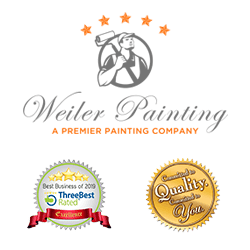With an increased awareness of our environment and the potential hazards within our daily lives, there has been a substantial shift in our choices of household products, particularly those involving volatile organic compounds (VOCs).
Among these products, paint has been under particular scrutiny. At Weiler Painting, our commitment to health, safety, and environment-friendly practices has led us to opt for Zero VOC paints consistently. Let’s delve into the reasons why.
Understanding VOCs
Volatile organic compounds (VOCs) evaporate quickly at room temperature and are found in a wide range of household products, including paint, cleaning, and air fresheners. The trouble starts when these VOCs escape into the atmosphere upon application or usage. They can cause health problems ranging from minor headaches and nausea to more severe conditions such as liver damage and cancer.
Despite the risks, VOCs are not mandated to be listed on product labels, making consumers often oblivious to the potential harm. The Environmental Protection Agency (EPA) considers some VOCs hazardous air pollutants, but awareness remains low.
The Use of VOCs in Paint
Why are VOCs incorporated into paint formulations? VOCs serve critical roles in the composition and functionality of paint. They help to dissolve or disperse the solid components of paint, enabling its smooth application on surfaces. This characteristic ensures the even distribution of pigments and binders during painting.
Advantages of VOC Paints
Additionally, VOCs assist in the drying process. These compounds evaporate upon application, allowing the paint to transition from liquid to solid. This property expedites the paint’s drying and curing time, which is beneficial from a practical standpoint, especially in commercial painting scenarios where time is often a significant constraint.
The Great Big Disadvantage of VOC
However, these advantageous characteristics are a double-edged sword. As VOCs facilitate paint transformation from a liquid to a solid, they evaporate into the indoor environment. This off-gassing can continue for several years after the paint has dried, leading to prolonged indoor exposure.
Despite the Environmental Protection Agency (EPA) setting regulations to limit the VOC content in paints, the fact remains that even restricted levels of these compounds can pose health risks. Particularly in indoor settings with limited ventilation, VOC levels can become concentrated, posing potential health threats to inhabitants.
Consequently, while the properties of VOCs are manipulated for the benefits they confer to paint performance, it is crucial to recognize and manage the health risks they concurrently pose, especially in spaces with prolonged human occupancy. It becomes apparent then that a shift towards safer alternatives, such as Zero VOC paints, is not only a healthier choice but a necessary one.
Dangers of VOC Paints in Detail
VOCs in paint can be harmful due to several reasons:
- Respiratory issues: VOCs can irritate the respiratory system, causing coughing, wheezing, and shortness of breath. They can exacerbate existing conditions like asthma and bronchitis.
- Carcinogenic effects: Certain VOCs have been associated with cancer in animals and humans. The EPA and the International Agency for Research on Cancer consider benzene, a specific VOC, a known human carcinogen.
- Environmental harm: VOCs can damage the ozone layer and contribute to smog formation, causing broader environmental issues.
The Benefits of Zero VOC Paints
As the name suggests, Zero VOC paints do not contain any volatile organic compounds, making them a safer and more responsible choice. Here’s why:
- Health: Zero VOC paints significantly reduce health risks by not releasing harmful chemicals into the air.
- Safety: The absence of VOCs makes these paints safer, posing no significant health threats.
- Durability: Zero VOC paints offer durability comparable to traditional paints, ensuring no compromise on longevity or performance.
Zero VOC Paints in Commercial Spaces
The implications of VOCs extend beyond residential settings and into commercial spaces. A fresh coat of paint on your business premises can inadvertently expose employees and customers to VOCs, causing adverse health effects such as headaches, dizziness, and nausea. Thankfully, low-VOC and Zero VOC paints meeting EPA standards, are available as safer alternatives.
Painting a Healthier Future with Weiler Painting
We believe in the right to clean, safe air for everyone, so we’re dedicated to using Zero VOC paints in our projects. If you’re looking for a healthier, more responsible way to paint your residential or commercial space, we’re here to help. With Weiler Painting, you’re not just enhancing the aesthetics of your space; you’re contributing to a healthier, safer environment.



